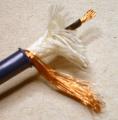
From The Cardas Website Regarding The Soldering Of
Litz Wires
- Use a solder pot (best, easiest and most reliable) Dip the wire in
flux and hold in the solder until fully tinned. Repeat if neccessary.
- Sand off (220-320-grit wet or dry unravel strand and lay flat on
table, a couple of strokes on each side) the insulation and use a little rosin
flux on the wire. With a good 900 degree Fahrenheit (482 degrees Celsius) tip
on a 100 watt iron you can pre-tin the wire.
- Twist a little piece of unenamled wire around the litz such as a
resistor lead and solder normally using using some rosin flux (such as Kester
sp88). Heat the bare copper wire you have wound around the litz and add solder
and rosin flux until you see the litz suck up the solder.
- If the wire is to be soldered to a pc board, placed through an
eyelet, crimped in a spade or other connector or otherwise surrounded by
solder. In a closed loop you can solder it by just putting a little rosin flux
on the wire as you twist the strands after stripping. On the surrounding piece
of metal heat the metal or the very tip of the Cardas litz and watch for the
smoke of the coating coming off and the tinning of the wire near the
surrounding metal.
- You can pre tin the wire by applying some rosin flux during the
striping operation and heating the very tip of the wire in a pool of solder on
the tip (850-900 degrees F) of a 100w Iron.
- You can get a large iron with a hot tip and dimple the tip so that it
will hold a little solder and use it for a solder pot. I have heard 100 other
ways over the years, but basically, if you can hold some hot solder around the
wire or at the tip of the conductor and use some rosin flux it will tin in a
second if the tip of the Iron is hot enough. The chief downfall of this method
is not using a hot enough or large enough iron. We use 100 watt Wellers with
900 degree F pencil tips. Anything this hot/big or bigger will work.
- The thinner the wire the easier it goes. The tonearm wires tin very
easily just by feeding them into thin spooled solder. The heavier wires like
the Coax Shield require the very hot tips or solder pot for complete tinning.
More effort, but very worth the effort to do it right.
For methods other than the solder pot method, it is best to use a
locking forcep as a heatsink to prevent the heat from traveling down the
insulation.
Close Window
